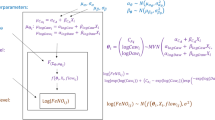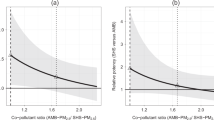Abstract
Field measurements of exhaled nitric oxide (FeNO) and ambient nitric oxide (NO) are useful to assess both respiratory health and short-term air pollution exposure. Online real-time measurement maximizes data quality and comparability with clinical studies, but offline delayed measurement may be more practical for large epidemiological studies. To facilitate cross-comparison in larger studies, we measured FeNO and concurrent ambient NO both online and offline in 362 children at 14 schools in 8 Southern California communities. Offline breath samples were collected in bags at 100 ml/s expiratory flow with deadspace discard; online FeNO was measured at 50 ml/s. Scrubbing of ambient NO from inhaled air appeared to be nearly 100% effective online, but 50–75% effective offline. Offline samples were stored at 2–8°C and analyzed 2–26 h later at a central laboratory. Offline and online FeNO showed a nearly (but not completely) linear relationship (R2=0.90); unadjusted means (ranges) were 10 (4–94) and 15 (3–181) p.p.b., respectively. Ambient NO concentration range was 0–212 p.p.b. Offline FeNO was positively related to ambient NO (r=0.30, P<0.0001), unlike online FeNO (r=0.09, P=0.08), indicating that ambient NO artifactually influenced offline measurements. Offline FeNO differed between schools (P<0.001); online FeNO did not (P=0.26), suggesting artifacts related to offline bag storage and transport. Artifact effects were small in comparison with between-subject variance of FeNO. An empirical statistical model predicting individual online FeNO from offline FeNO, ambient NO, and lag time before offline analysis gave R2=0.94. Analyses of school or age differences yielded similar results from measured or model-predicted online FeNO. Conclusions: Either online or offline measurement of exhaled NO and concurrent ambient NO can be useful in field epidemiology. Influence of ambient NO on exhaled NO should be examined carefully, particularly for offline measurements.
This is a preview of subscription content, access via your institution
Access options
Subscribe to this journal
Receive 6 print issues and online access
$259.00 per year
only $43.17 per issue
Buy this article
- Purchase on Springer Link
- Instant access to full article PDF
Prices may be subject to local taxes which are calculated during checkout





Similar content being viewed by others
References
American Thoracic Society. Recommendations for standardized procedures for the online and offline measurement of exhaled lower respiratory nitric oxide and nasal nitric oxide in adults and children. Am J Respir Crit Care Med 1999: 160: 2104–2117.
American Thoracic Society. ATS/ERS recommendations for standardized procedures for the online and offline measurement of exhaled lower respiratory nitric oxide and nasal nitric oxide. Am J Respir Crit Care Med 2005: 171: 912–930.
Baraldi E., and DeJongste J.C. European Respiratory Society/American Thoracic Society Statement: measurement of exhaled nitric oxide in children. Eur Respir J 2002: 20: 223–237.
Barreto M., Villa M.P., Martella S., Falasca C., Guglielmi F., Pagani J., et al. Off-line exhaled nitric oxide measurements in children. Pediatr Pulmonol 2001: 32: 159–167.
Delfino R.J., Staimer N., Gillen D., Tjoa T., Sioutas C., Fung K., et al. Personal and ambient air pollution is associated with increased exhaled nitric oxide in children with asthma. Environ Health Perspect 2006: 114: 1736–1743.
Deykin A., Massaro A.F., Drazen J.M., and Israel E. Exhaled nitric oxide as a diagnostic test for asthma: online versus offline techniques and effect of flow rate. Am J Respir Crit Care Med 2002: 165: 1597–1601.
DuBois A.B., Kelley P.M., Douglas J.S., and Mohsenin V. Nitric oxide production and absorption in trachea, bronchi, bronchioles, and respiratory bronchioles of humans. J Appl Physiol 1999: 86: 159–167.
Freund R.J., and Littell R.C. SAS System for Regression. 2nd edn. SAS Institute, Cary, NC, 2000, pp. 164 ff.
Gauderman W.J., Avol E., Gilliland F., Vora H., Thomas D., Berhane K., et al. The effect of air pollution on lung development from 10 to 18 years of age. N Engl J Med 2004: 351: 1057–1067.
George S.C., Hogman M., Permutt S., and Silkoff P.E. Modeling pulmonary nitric oxide exchange. J Appl Physiol 2004: 96: 831–839.
Jöbsis Q., Raatgeep H.C., Hop W.C., and de Jongste J.C. Controlled low flow off line sampling of exhaled nitric oxide in children. Thorax 2001: 56: 285–289.
Kharitonov S.A., and Barnes P.J. State of the art: exhaled markers of pulmonary disease. Am J Respir Crit Care Med 2001: 163: 1693–1722.
Kharitonov S.A., and Barnes P.J. Exhaled biomarkers. Chest 2006: 130: 1541–1546.
Kissoon N., Duckworth L.J., Blake K.V., Murphy S.P., Taylor C.L., DeNicola L.R., and Silkoff P.E. Exhaled nitric oxide concentrations: online versus offline values in healthy children. Pediatr Pulmonol 2002: 33: 283–292.
Linn W.S., Avila M., and Gong H. Exhaled nitric oxide: sources of error in offline measurement. Arch Environ Heal 2004: 59: 385–391.
Linn W.S., Berhane K.T., Rappaport E.B., Bastain T.M., Avol E.L., and Gilliland F.D. Southern California Environmental Health Sciences Center Respiratory Effects Technical Report No. 2008-1: Relationships of Online Exhaled, Offline Exhaled, and Ambient Nitric Oxide in an Epidemiologic Survey of Schoolchildren, Southern California Environmental Health Sciences Center, Los Angeles, 2008: http://hydra.usc.edu/occenvhealth/TechReports.asp.
Mar T.F., Jansen K., Shepherd K., Lumley T., Larson T.V., and Koenig J.Q. Exhaled nitric oxide in children with asthma and short-term PM2.5 exposure in Seattle. Environ Health Perspect 2005: 113: 1791–1794.
Peters J.M., Avol E., Navidi W., London S.J., Gauderman W.J., Lurmann F., et al. A study of 12 southern California communities with differing levels and types of air pollution. Am J Respir Crit Care Med 1999: 159: 760–767 (part I), 768–775 (part II).
Ricciardolo F.L., Sterk P.J., Gaston B., and Folkerts G. Nitric oxide in health and disease of the respiratory system. Physiol Rev 2004: 84: 731–765.
Taylor D.R., Pijnenburg M.W., Smith A.D., and DeJongste J.C. Exhaled nitric oxide measurements: clinical application and interpretation. Thorax 2006: 61: 817–827.
Tadaki H., Mochizuki H., Muramastu R., Hagiwara S., Mizuno T., Arakawa H., and Morikawa A. A flow- and pressure-controlled offline method of exhaled nitric oxide measurement in children. Ann Allergy Asthma Immunol 2008: 100: 308–313.
Zeidler M.R., Kleerup E.C., and Tashkin D.P. Exhaled nitric oxide in the assessment of asthma. Curr Opin Pulm Med 2004: 10: 31–36.
Acknowledgements
We acknowledge the contributions of the field testing team: S. Howland (leader), R. Diaz, N. Realiza, and H. Valencia, and laboratory staff: M. Avila and L. Valencia. This work was supported by the National Heart, Lung and Blood Institute (grant 5R01HL076647); the Southern California Environmental Health Sciences Center (grant no. 5P30ES007048) funded by the National Institute of Environmental Health Sciences; the Children's Environmental Health Center (grant nos 5P01ES009581, R826708-01, and RD831861-01) funded by the National Institute of Environmental Health Sciences and the Environmental Protection Agency; the National Institute of Environmental Health Sciences (grant no. 5P01ES011627); and the Hastings Foundation.
Author information
Authors and Affiliations
Corresponding author
Rights and permissions
About this article
Cite this article
Linn, W., Berhane, K., Rappaport, E. et al. Relationships of online exhaled, offline exhaled, and ambient nitric oxide in an epidemiologic survey of schoolchildren. J Expo Sci Environ Epidemiol 19, 674–681 (2009). https://doi.org/10.1038/jes.2008.64
Received:
Accepted:
Published:
Issue Date:
DOI: https://doi.org/10.1038/jes.2008.64
Keywords
This article is cited by
-
Genetic and epigenetic susceptibility of airway inflammation to PM2.5 in school children: new insights from quantile regression
Environmental Health (2017)
-
Storage conditions for stability of offline measurement of fractional exhaled nitric oxide after collection for epidemiologic research
BMC Pulmonary Medicine (2012)
-
Domestic airborne black carbon and exhaled nitric oxide in children in NYC
Journal of Exposure Science & Environmental Epidemiology (2012)
-
Relationships of online exhaled, offline exhaled, and ambient nitric oxide in an epidemiologic survey of schoolchildren
Journal of Exposure Science & Environmental Epidemiology (2009)



